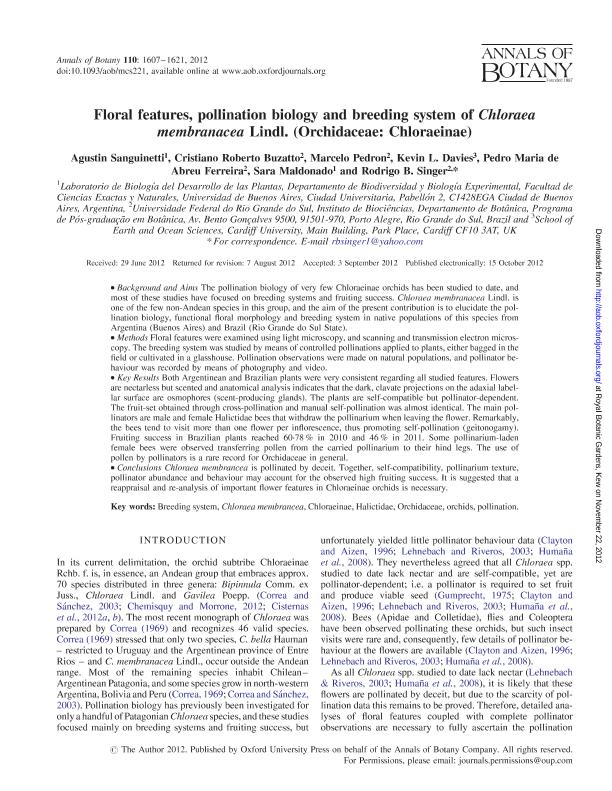Mostrar el registro sencillo del ítem
dc.contributor.author
Sanguinetti, Agustin

dc.contributor.author
Buzatto, Cristiano Roberto
dc.contributor.author
Pedron, Marcelo
dc.contributor.author
Davies, Kevin L.
dc.contributor.author
Ferreira, Pedro Maria De Abreu
dc.contributor.author
Maldonado, Sara Beatriz

dc.contributor.author
Singer, Rodrigo Bustos

dc.date.available
2020-09-03T20:42:20Z
dc.date.issued
2012-12
dc.identifier.citation
Sanguinetti, Agustin; Buzatto, Cristiano Roberto; Pedron, Marcelo; Davies, Kevin L.; Ferreira, Pedro Maria De Abreu; et al.; Floral features, pollination biology and breeding system of Chloraea membranacea Lindl. (Orchidaceae: Chloraeinae); Oxford University Press; Annals of Botany; 110; 8; 12-2012; 1607-1621
dc.identifier.issn
0305-7364
dc.identifier.uri
http://hdl.handle.net/11336/113179
dc.description.abstract
Background and Aims: The pollination biology of very few Chloraeinae orchids has been studied to date, and most of these studies have focused on breeding systems and fruiting success. Chloraea membranacea Lindl. is one of the few non-Andean species in this group, and the aim of the present contribution is to elucidate the pollination biology, functional floral morphology and breeding system in native populations of this species from Argentina (Buenos Aires) and Brazil (Rio Grande do Sul State). Methods:Floral features were examined using light microscopy, and scanning and transmission electron microscopy. The breeding system was studied by means of controlled pollinations applied to plants, either bagged in the field or cultivated in a glasshouse. Pollination observations were made on natural populations, and pollinator behaviour was recorded by means of photography and video.Key ResultsBoth Argentinean and Brazilian plants were very consistent regarding all studied features. Flowers are nectarless but scented and anatomical analysis indicates that the dark, clavate projections on the adaxial labellar surface are osmophores (scent-producing glands). The plants are self-compatible but pollinator-dependent. The fruit-set obtained through cross-pollination and manual self-pollination was almost identical. The main pollinators are male and female Halictidae bees that withdraw the pollinarium when leaving the flower. Remarkably, the bees tend to visit more than one flower per inflorescence, thus promoting self-pollination (geitonogamy). Fruiting success in Brazilian plants reached 60·78 in 2010 and 46 in 2011. Some pollinarium-laden female bees were observed transferring pollen from the carried pollinarium to their hind legs. The use of pollen by pollinators is a rare record for Orchidaceae in general.ConclusionsChloraea membrancea is pollinated by deceit. Together, self-compatibility, pollinarium texture, pollinator abundance and behaviour may account for the observed high fruiting success. It is suggested that a reappraisal and re-analysis of important flower features in Chloraeinae orchids is necessary.
dc.format
application/pdf
dc.language.iso
eng
dc.publisher
Oxford University Press

dc.rights
info:eu-repo/semantics/openAccess
dc.rights.uri
https://creativecommons.org/licenses/by-nc-sa/2.5/ar/
dc.subject
BREEDING SYSTEM
dc.subject
CHLORAEA MEMBRANCEA
dc.subject
CHLORAEINAE
dc.subject
HALICTIDAE
dc.subject
ORCHIDACEAE
dc.subject
ORCHIDS
dc.subject
POLLINATION
dc.subject.classification
Ciencias de las Plantas, Botánica

dc.subject.classification
Ciencias Biológicas

dc.subject.classification
CIENCIAS NATURALES Y EXACTAS

dc.title
Floral features, pollination biology and breeding system of Chloraea membranacea Lindl. (Orchidaceae: Chloraeinae)
dc.type
info:eu-repo/semantics/article
dc.type
info:ar-repo/semantics/artículo
dc.type
info:eu-repo/semantics/publishedVersion
dc.date.updated
2020-05-11T16:46:24Z
dc.journal.volume
110
dc.journal.number
8
dc.journal.pagination
1607-1621
dc.journal.pais
Reino Unido

dc.journal.ciudad
Oxford
dc.description.fil
Fil: Sanguinetti, Agustin. Consejo Nacional de Investigaciones Científicas y Técnicas. Oficina de Coordinación Administrativa Ciudad Universitaria; Argentina. Universidad de Buenos Aires. Facultad de Ciencias Exactas y Naturales. Departamento de Biodiversidad y Biología Experimental; Argentina
dc.description.fil
Fil: Buzatto, Cristiano Roberto. Universidade Federal do Rio Grande do Sul; Brasil
dc.description.fil
Fil: Pedron, Marcelo. Universidade Federal do Rio Grande do Sul; Brasil
dc.description.fil
Fil: Davies, Kevin L.. Cardiff University; Reino Unido
dc.description.fil
Fil: Ferreira, Pedro Maria De Abreu. Universidade Federal do Rio Grande do Sul; Brasil
dc.description.fil
Fil: Maldonado, Sara Beatriz. Universidad de Buenos Aires. Facultad de Ciencias Exactas y Naturales. Departamento de Biodiversidad y Biología Experimental; Argentina. Consejo Nacional de Investigaciones Científicas y Técnicas. Oficina de Coordinación Administrativa Ciudad Universitaria; Argentina
dc.description.fil
Fil: Singer, Rodrigo Bustos. Universidade Federal do Rio Grande do Sul; Brasil
dc.journal.title
Annals of Botany

dc.relation.alternativeid
info:eu-repo/semantics/altIdentifier/url/https://academic.oup.com/aob/article/110/8/1607/160222
dc.relation.alternativeid
info:eu-repo/semantics/altIdentifier/doi/https://doi.org/10.1093/aob/mcs221
Archivos asociados
